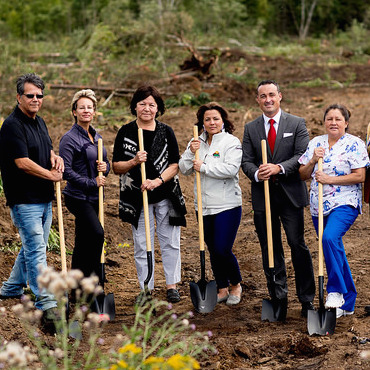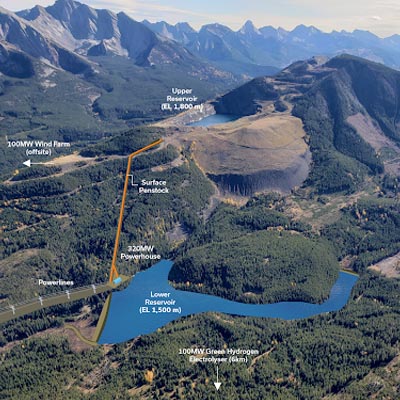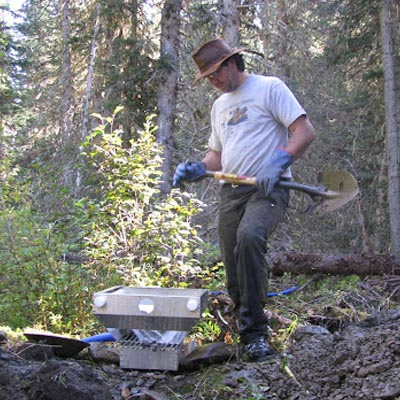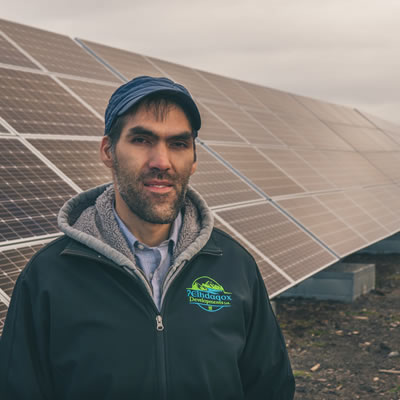Thunder Bay joint venture with First Nation builds housing subdivision

Subdivision ground breaking day. — Photo courtesy Oshki-Aki LP A joint venture created by True Grit Consulting Ltd and Fort William First Nation is
Subdivision ground breaking day. — Photo courtesy Oshki-Aki LP
A joint venture created by True Grit Consulting Ltd and Fort William First Nation is close to completing the first part of a residential project on a First Nation in Thunder Bay, Ontario.
Adam Rose, True Grit's principal and manager of engineering service, said Oshki-Aki Limited Partnership (New Earth) is expecting to complete all roads, lots, infrastructure and water and sewer services by November 2015.
“And we anticipate to start building the homes in spring 2016,” Rose said.
The houses will be occupied by members of Fort William First Nation (FWFN). The 21-lot subdivision is the first phase of an expansion of the residential part of the FWFN. The project, which started construction in 2014, is located at the most northerly limits of Thunder Bay. The city is situated on the north shore of Lake Superior in northwestern Ontario.
Rose said the subdivision was designed with an open-cut ditch drainage system that includes a sub-drain system that can handle any problems caused by the area's high ground water table. The site required a grade raise.
“We imported fill to ensure the sanitary sewer grades were able to connect to the existing system and to create adequate drainage of the surface water,” Rose said.
The subdivision was designed with a green space that can be used in the future as a recreational area.
“And a storm water management pond ensures that the quantity and quality of surface water are effectively controlled on site and do not impact downstream areas,” Rose said.
True Grit Consulting acts as the design and project management team that represents FWFN.
“We work collaboratively with the chief, council and the band administration to make sure all of the project's objectives are being met,” Rose said. “The First Nation wants to ensure the resources and capacity of the community are used to the fullest extent and contribute to job creation and the building of skills.”
The FWFN team includes public works staff, administration and council.
“That allows for effective decision making and guidance during construction,” Rose said.
Members of FWFN work on the project as environmental technicians, surveyors and material testing technicians.
In addition, First Nations companies provide materials and services. Mount McKay Heavy Equipment, a locally owned First Nations construction company, was hired by Nadin Contracting Ltd., the prime contractor on the project, for earth works, site services and sewer and water installation work.
In addition to public works, FWFN provides sand and gravel from its nearby quarry. Altogether, between 10 and 15 First Nations are employed on the project.
Rose said no major problems have come up during construction.
“There were, however, some minor challenges,” he said. “They included a relatively wet and low-lying original ground that required interim grading and water management by the contractor.”
Oshki-Aki Limited Partnership was incorporated in 2011. The joint venture creates employment and mentorship opportunities for FWFN members and builds skills toward permanent careers in consulting and engineering.
Although it is only a few years old, the joint venture has already taken part in a number of projects: Resurfacing 12 kilometres of road on the reserve; a three-year project that includes a $3-million reconstruction of the Mission Road main street to bring it up to modern standards by this fall; and upgrading the FWFN pow-wow grounds, which was completed in spring 2015.
Looking ahead, the joint venture has other projects either on the go or on the books.
They include a major expansion and upgrade of the sewage lagoon system; managing and engineering a new 30,000-square-foot office building project; a community drainage study, designs for arena parking lot expansion and improvement; a breakwater study for the City of Thunder Bay, and a storm water control study for the Lac des Iles mine.
On the horizon are further subdivision expansion, aggregate development, land development and infrastructure upgrades.
Lac des Iles storm water control study
The Oshki-Aki joint venture between True Grit Consulting Ltd. and Fort William First Nation is updating the storm water control studies for North American Palladium Ltd.'s Lac des Iles mine. The mine is about 90 kilometres northeast of Thunder Bay.
The purpose of the study is to ensure the current control system is up to date and conforms with the standards of the Ministry of the Environment.
Work on the project began in December 2014 and a report is expected to be delivered to North American Palladium in November 2015.
Annual monitoring for physical and chemical stability of water surrounding the property is ongoing and will be continued years after the mine has closed.
Every three years there is an extensive biological monitoring study that covers an area of 300 square kilometres around the mine site. To date, no negative trends have been associated with the Lac des Iles mine on the surrounding ecosystem.
The Oshki-Aki joint venture between True Grit Consulting Ltd. and Fort William First Nation is updating the storm water control studies for North American Palladium Ltd.'s Lac des Iles mine. The mine is about 90 kilometres northeast of Thunder Bay.
The purpose of the study is to ensure the current control system is up to date and conforms with the standards of the Ministry of the Environment.
Work on the project began in December 2014 and a report is expected to be delivered to North American Palladium in November 2015.
Annual monitoring for physical and chemical stability of water surrounding the property is ongoing and will be continued years after the mine has closed.
Every three years there is an extensive biological monitoring study that covers an area of 300 square kilometres around the mine site. To date, no negative trends have been associated with the Lac des Iles mine on the surrounding ecosystem.



